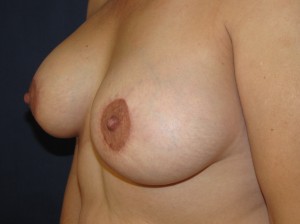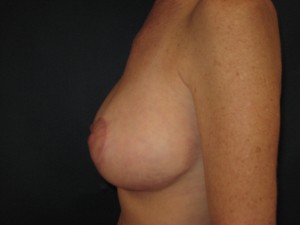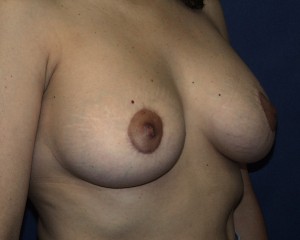A periareolar mastopexy, also known as a purse string, doughnut or circumareolar mastopexy, is a breast lift that accomplishes the result with just one incision: around the areola. Many women find the idea attractive because of the idea that there may be fewer scars on the breast. Unfortunately, unless there is minimal drooping to begin with, the trade-off is a poorly shaped flattened breast.
The goal of a breast lift or mastopexy is to recreate a more somewhat conical shaped breast with the nipple-areola situated at the summit of the most projecting part. A “standard” inverted-T or anchor shaped incision allows for precise reshaping of the skin envelope in addition to the underlying breast tissue by utilizing a three dimensional approach. The nipple-areola complex can then be more accurately placed and sized so as to result in an aesthetically pleasing contoured breast.
The periareolar mastopexy approach eliminates the vertical scar as well as the horizontal scar in the fold at the bottom of the breast. Through a two dimensional approach involving just the incision around the areola, it has to both lift and reshape the breast. It accomplishes both by removing excess skin asymmetrically around the areola, taking a larger circle and purse stringing it to make a smaller circle, thereby tightening the skin.
With this approach, the area of maximum tension is centered around the areola. Some of the untoward consequences of this can include but are not limited to:
1.) a flattening of the breast shape creating more of a pancake configuration than a cone
2.) stretching and flattening of the areola causing distortions and irregularities of shape
3.) unsightly pleating of bunched up skin around the areola resulting from the purse string closure
4.) widened and thickened scars around the areola
5.) limitations in the precise positioning of the areola on the breast
6.) difficulty in obtaining closer symmetry is breasts that are significantly different prior to surgery

Periareolar Mastopexy (A). Though mild in this case, flatness and some pleating of the skin of the left breast can be seen centered at the areola (not my patient)
I strongly feel that a periareolar mastopexy is very rarely indicated except for certain limited situations involving very minor drooping. The trade-offs as noted above are too high a price to pay for most women versus the far superior results that can be obtained with a few more incisions.
If you would like additional information on breast lifts, breast augmentation or any other cosmetic surgery procedure that I perform, you can contact my office at 480-451-3000.
Steven H. Turkeltaub, M.D. P.C.
Scottsdale and Phoenix, Arizona


